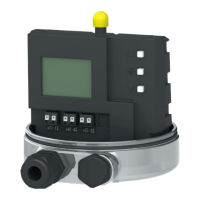3-4 EB 8048-2 EN
Design and principle of operation
3.1 Fail-safe action
The fail-safe position depends on the mount-
ed actuator. Depending on how the com-
pression springs are arranged in the pneu-
matic actuator, the valve has two different
fail-safe positions:
− Actuator stem extends (FA)
When the signal pressure is reduced or
the air supply fails, the springs move the
actuator stem downward and close the
valve. The valve opens when the signal
pressure is increased enough to over-
come the force exerted by the springs.
− Actuator stem retracts (FE)
When the signal pressure is reduced or
the air supply fails, the springs move the
actuator stem upwards and open the
valve. The valve closes when the signal
pressure is increased enough to over-
come the force exerted by the springs.
The direction of action of the Type3271 and
Type3277 Actuators can be reversed, if re-
quired. Refer to the operating and mounting
instructions of the pneumatic actuator:
uEB8310-X for Type3271 and
Type3277.
Contact SAMSON to reverse the direction of
action of the Type3379 Actuator.
3.2 Versions
Micro-ow valve
The Type3349 Valve is also available as a
micro-ow valve for K
VS
coefcients <0.4:
With
actuator
Valve size Flow coefcient
DN NPS K
VS
C
V
Type3271
Type3277
6…25 ¼…1
0.01…
0.25
0.012
…0.3
Type3379 6…25 ¼…1
0.01…
0.25
0.012
…0.3
Actuators
In these instructions, the preferable combina-
tion with the Type3271 and Type3277
Pneumatic Actuators as well as the
Type3379 Pneumatic Piston Actuator is de-
scribed. The Type3271 and Type3277
Pneumatic Actuators (with or without hand-
wheel) can be replaced by another pneumat-
ic actuator in a different size, but with the
same travel.
Î Observe the maximum permissible actu-
ator force.
If the travel range of the actuator is larger
than the travel range of the valve, the spring
assembly in the actuator must be preloaded
so that the travel ranges match. See associ-
ated actuator documentation.
Tip
Note

